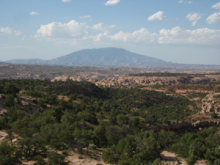Article
Also known as “Naatsis’áán” in Diné. A dome-shaped mountain (elevation 10,388 ft) that straddles the Utah-Arizona border, with its highest peak on the Utah side. It is the easiest landmark to spot in western Navajo country and is considered sacred by local indigenous groups including the Navajo, the Paiute, and the Hopi. In the Navajo tradition, the mountain represents the head of the female corn pollen spirit, Earth Woman. The mountain also features prominently in the Navajo Coyoteway story.
While Navajo Mountain is not one of the four sacred mountains of the Navajo origin story, it is believed to be a mountain that emerged after the creation of the earth due to its own powers, which include curing sickness and bringing rain. Because of the mountain's location on a border and near the Rainbow Bridge, another important feature in the Navajo origin story, the mountain served as a peaceful meeting ground between the Navajo and Paiute. While many areas surrounding Navajo Mountain are available for hiking and camping as part of the Navajo Nation Tribal Park, because of the sacredness of the mountain, climbing and summiting the peak are forbidden.
"Navajo Mountain as seen from S.R. 98, near Kaibito, Arizona, July 4, 2010" by Ken Lund.
Manuscripts
References
Bitsinnie, Alex
N.d. Navajo Mountain Chapter. Navajo Chapters.
http://navajomountain.navajochapters.org/, accessed February 16, 2015.
Linford, Laurance
2001 Tony’s Hillerman’s Navajoland. Salt Lake City: University of Utah Press.
Long, Clayton and Harold Carey
N.d. Navajo Mountain -- Head of the Earth. Navajo People Culture and History. http://navajopeople.org/blog/navajo-mountain-head-of-the-earth/, accessed February 16,
2015.
Navajo Nation Parks and Recreation
N.d. Travel Navajo Nation. Http://www.navajonationparks.org/permits.htm, accessed
February 15, 2015.

